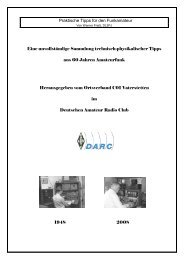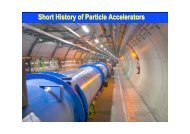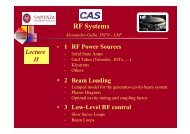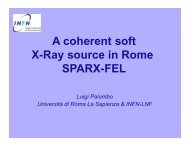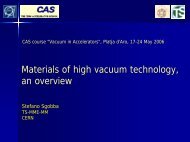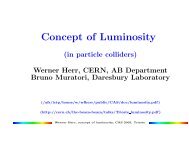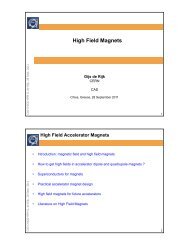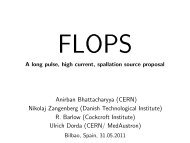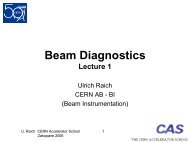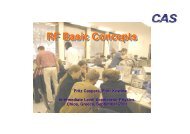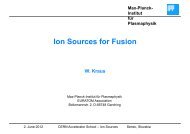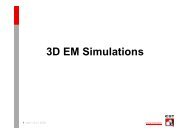mode - CERN Accelerator School
mode - CERN Accelerator School
mode - CERN Accelerator School
Create successful ePaper yourself
Turn your PDF publications into a flip-book with our unique Google optimized e-Paper software.
Introduction to RF Linear <strong>Accelerator</strong>s<br />
Maurizio Vretenar – <strong>CERN</strong> AB/RF<br />
1. Why linear accelerators - basic concepts<br />
22. Periodic Accelerating Structures<br />
3. Overview of linac structures<br />
4. Basics of linac beam dynamics<br />
5. More on periodic structures<br />
6. The RFQ<br />
7. Linac Technology gy<br />
1
Linacs are mostly used for:<br />
Why y Linear <strong>Accelerator</strong>s<br />
11. LLow-Energy E accelerators l t s (i (injectors j t s tto ssynchrotrons h t s or st stand-alone) d l )<br />
for protons and ions, linear accelerators are synchronous with the RF<br />
fields in the region where velocity increases with energy. As soon as<br />
velocity y is ~constant, , synchrotrons y are more m efficient ff (multi-pass<br />
(m p<br />
instead of single pass).<br />
2. Production of high-intensity proton beams<br />
in comparison with synchrotrons, linacs can go to higher repetition rate,<br />
are less affected by resonances and have losses more distributed →<br />
more suitable for high intensity beams (but in competition with<br />
cyclotrons…).<br />
3. High energy lepton colliders for electrons at high energy,<br />
main advantage is the absence of synchrotron radiation.<br />
2
(v/c)^2 (<br />
1<br />
Proton and Electron Velocity<br />
electrons<br />
“Einstein”<br />
protons<br />
0<br />
0 100 200 300 400 500<br />
Kinetic Energy [MeV]<br />
β2 =(v/c) 2 as function of kinetic<br />
energy T for protons and<br />
electrons. l t<br />
Relativistic (Einstein) relation:<br />
2<br />
T = m 0 0c<br />
(<br />
1<br />
2<br />
1−<br />
v<br />
2<br />
−1<br />
) = m0c<br />
( γ −1<br />
)<br />
2<br />
0 γ<br />
c<br />
Classic (Newton) relation:<br />
2<br />
2<br />
v<br />
2 1 v<br />
T = m0<br />
= m0c<br />
( ) 2<br />
2 2 c<br />
→ Protons (rest energy 938.3 MeV): follow “Newton” mechanics up to some tens of MeV<br />
(Δ (Δv/v / < 1% for f W < 15 MeV) M V) then th slowly l l become b relativistic l ti i ti (“Ei (“Einstein”). t i ”) FFrom th the GGeV V<br />
range velocity is nearly constant (v~0.95c at 2 GeV) → linacs can cope with the<br />
increasing particle velocity, synchrotrons are more efficient for v nearly constant.<br />
→ Electrons (rest energy 511 keV, keV 1/1836 of protons): relativistic from the keV range<br />
(v~0.1c at 2.5 keV) then increasing velocity up to the MeV range (v~0.95c at 1.1 MeV)<br />
→ v~c after few meters of acceleration in a linac (typical gradient 10 MeV/m).<br />
3
Beam<br />
Synchronism y condition<br />
The distance between accelerating gaps is proportional to particle velocity<br />
Electric field<br />
(tti (at time tt) 0 )<br />
1<br />
0.5<br />
0<br />
0 2 0 4 0 6 0 8 0 1 0 0 1 2 0 z<br />
-0 .5<br />
-1<br />
l=βλ/2<br />
Example: a linac superconducting 4-cell<br />
accelerating structure<br />
Synchronism condition:<br />
t (travel between centers of cells) = T/2<br />
l 1<br />
=<br />
βc<br />
2 f<br />
l<br />
β c<br />
= =<br />
2 = = f<br />
βλ<br />
2<br />
1. In an ion linac cell length has to increase (up to a factor 200 !) and the linac will<br />
be made of a sequence of different accelerating structures (changing cell<br />
length, frequency, operating <strong>mode</strong>, etc.) matched to the ion velocity.<br />
2. For electron linacs, β =1, l =λ/2 → An electron linac will be made of an injector +<br />
a series i of f id identical ti l accelerating l ti structures, t t with ith cells ll all ll the th same length l th<br />
Note: in the example above, we have synchronism only if we neglect the<br />
increase in beta inside the structure !<br />
4
Example: Superconducting<br />
Proton Linac<br />
The same Superconducting cavity design can be used for different proton beta’s,<br />
just changing the cell length accordingly to beta.<br />
β=0.52<br />
β=0.7<br />
β=0.8<br />
β=1 β<br />
<strong>CERN</strong> (old) SPL design, SC linac 120 - 2200 MeV, 680 m length, 230 cavities<br />
5
2 – Periodic Accelerating<br />
Structures<br />
6
RF input<br />
λ p<br />
TM01 field configuration<br />
Wave propagation in a<br />
cylindrical pipe<br />
E-field<br />
B-field<br />
In a cylindrical waveguide different <strong>mode</strong>s can<br />
propagate (=Electromagnetic field distributions,<br />
ttransmitting itti power and/or d/ iinformation). f ti ) Th The fi field ld iis<br />
the superposition of waves reflected by the metallic<br />
walls of the pipe → velocity and wavelength of the<br />
<strong>mode</strong>s will be different from free space p (c, λ)<br />
To accelerate particles, we need a <strong>mode</strong> with<br />
longitudinal E-field component on axis: a TM <strong>mode</strong><br />
(Transverse Magnetic, B z=0). The simplest is TM01.<br />
We enter RF power at a frequency exciting the TM01<br />
<strong>mode</strong>: E-field periodic on axis, wavelength λ p depends<br />
on frequency and on cylinder radius. Wave velocity<br />
( (called ll d “ph “phase s velocity”) l it ”) is vph= λ λp/T /T = λ λpf f = ω/k /kz with ith<br />
kz=2π/λp The relation between frequency ω and propagation<br />
constant k is the DISPERSION RELATION (red<br />
curve on plot), a fundamental property of waveguides.<br />
7
Wave velocity: the dispersion<br />
relation<br />
The relation ω(k) can be calculated from the standard theory of waveguides:<br />
ω2 = k2c2 + ω 2<br />
c Plotting g this curve (hyperbola), ( yp ), we see that:<br />
k=2π/λ p<br />
0<br />
ω<br />
1) There is a “cut-off frequency”, below which a wave<br />
will not propagate. It depends on dimensions<br />
(λc=2.61a for the cylindrical waveguide).<br />
vph>c ( c y g )<br />
vph=c<br />
tg α = ω/kz = vph<br />
v ph=ω/k = (c 2 +ω c 2 /k 2 ) 1/2<br />
v g=dω/dk<br />
kz<br />
2) At each excitation frequency is associated a phase<br />
velocity, the velocity at which a certain phase<br />
travels in the waveguide. vp=∞ at k=0, ω=ωc and<br />
then h decreases d towards d vp=c ffor kk,ω→∞.<br />
3) Energy (and information) travel at group velocity<br />
dω/dk, which is between 0 and c. This velocity has<br />
to respect the relativity principle!<br />
4) A particle traveling inside our cylinder has to<br />
travel at v = v ph to see a constant accelerating Efield<br />
→ should travel at v > c !!!<br />
5) To use the waveguide to accelerate particles, we<br />
need a “trick” to slow down the wave. 8
Slowing down waves: the disc-<br />
loaded waveguide<br />
Discs inside the cylindrical waveguide, spaced by a distance l , will<br />
ind induce mmultiple ltipl reflections fl ti ns bbetween t n th the dis discs. s<br />
9
ω<br />
electric field pattern - <strong>mode</strong> A<br />
60<br />
50<br />
40<br />
30<br />
20<br />
10<br />
0<br />
open waveguide<br />
dispersion curve<br />
Dispersion relation for the<br />
disc-loaded waveguide<br />
<strong>mode</strong> B<br />
electric field pattern - <strong>mode</strong> B<br />
<strong>mode</strong> A<br />
0 40 k=2π/λ<br />
Wavelengths with λp/2~ l will be most affected by<br />
the discs discs. On the contrary contrary, for λ λp=0 =0 and λ λp=∞ =∞ the<br />
wave does not see the discs → the dispersion<br />
curve remains that of the empty pipe.<br />
At λ λp/2= /2= l , the wave will be confined between the<br />
discs, and present 2 “polarizations” (<strong>mode</strong> A and B<br />
in the figure), 2 <strong>mode</strong>s with same wavelength but<br />
different frequencies → the dispersion curve<br />
splits into 2 branches, separated by a stop band.<br />
In the disc-loaded waveguide, the lower branch of<br />
the dispersion curve is now “distorted” in such a<br />
way that h we can find f d a range of f ffrequencies with h<br />
vph = c → we can use it to accelerate a particle<br />
beam!<br />
WWe have h built a linac lin c for f v~c c → a TRAVELING<br />
WAVE (TW) ELECTRON LINAC<br />
10
eam<br />
Traveling wave linac<br />
structures<br />
→ Disc-loaded waveguide designed for v ph=c at a given frequency, equipped with an input<br />
and an output coupler.<br />
→ RF power is introduced via the input coupler. Part of RF power is dissipated in the<br />
structure, part is taken by the beam (beam loading) and the rest is absorbed in a<br />
matched load at the end of the structure. Usually, structure length is such that ~30%<br />
of power goes to the load. load<br />
→ The “traveling wave” structure is the standard linac for electrons from β~1.<br />
→ Can not be used for ions at v
Standing wave linac<br />
structures<br />
d 0<br />
To obtain an accelerating structure for ions we<br />
close our disc-loaded structure at both ends with<br />
metallic walls → multiple reflections of the waves.<br />
Boundary condition at both ends is that electric<br />
field must be perpendicular to the cover → Only<br />
some <strong>mode</strong>s on the disc-loaded dispersion curve<br />
are allowed → only some frequencies on the<br />
dispersion curve are permitted permitted.<br />
In general:<br />
1. the <strong>mode</strong>s allowed will be equally spaced in k<br />
E<br />
ω<br />
0 6.67 13.34 20.01 26.68 33.35<br />
22. The number of <strong>mode</strong>s will be identical to the number of cells (N cells → N<strong>mode</strong>s) N <strong>mode</strong>s)<br />
3. k represents the phase difference between the field in adjacent cells.<br />
0<br />
π/2<br />
π<br />
12<br />
k
<strong>mode</strong> 0<br />
<strong>mode</strong> π/2<br />
<strong>mode</strong> 2π/3<br />
<strong>mode</strong> π<br />
More on standing wave<br />
structures<br />
E<br />
1<br />
0.8<br />
0.6<br />
0.4<br />
0.2<br />
0<br />
0 50 100150 200 250<br />
1.5<br />
1<br />
0.5<br />
0<br />
-0.5 0<br />
-1<br />
-1.5<br />
50 100150 200 250<br />
1.5<br />
1<br />
0.5<br />
0<br />
-0.5 0 50 100 150 200 250<br />
-1<br />
-1.5<br />
1.5<br />
1<br />
0.5<br />
0<br />
-0.5 0 50 100 150 200 250<br />
Standing wave <strong>mode</strong>s are named from the<br />
phase difference between adjacent cells: in<br />
the example above, <strong>mode</strong> 0, π/2, 2π/3, π.<br />
In standing wave structures, cell length can<br />
be matched to the particle velocity !<br />
-1<br />
-1.5<br />
z<br />
→ These STANDING WAVE MODES<br />
are generated by the sum of 2<br />
traveling waves in opposite<br />
directions, adding always in the same<br />
way in the different cells.<br />
→ For acceleration, the particles must<br />
be in phase with the E-field on axis.<br />
We have already seen the π <strong>mode</strong>:<br />
synchronism condition for cell length<br />
l = βλ/2.<br />
→ Standing wave structures can be<br />
used for any β (→ ions and<br />
electrons) and can follow the<br />
increase in β of the ions.<br />
Synchronism conditions:<br />
0-<strong>mode</strong> : l = βλ<br />
π/2 <strong>mode</strong>: 2 l = βλ/2<br />
π <strong>mode</strong>: l = βλ/2<br />
13
“Practical” standing wave<br />
structures<br />
From disc-loaded structure to a real cavity (Linac4 PIMS, Pi-Mode Structure)<br />
1. To increase acceleration efficiency (=shunt impedance ZT2 !) we need to<br />
concentrate electric field on axis (Z) (Z) and to shorten the gap (T) (T) →<br />
introduction of “noses” on the openings.<br />
2. The smaller opening would not allow the wave to propagate →<br />
introduction of “coupling p g slots” between cells.<br />
3. The RF wave has to be coupled into the cavity from one point, usually in<br />
the center.<br />
14
Comparing traveling and<br />
standing wave structures<br />
Standing wave Traveling wave<br />
Chain of coupled cells in SW <strong>mode</strong>.<br />
CCoupling li (bw. (b cells) ll ) bby slots l ( (or open). ) OOn<br />
axis aperture reduced, higher E-field<br />
on axis and power efficiency.<br />
RF power from a coupling port, dissipated<br />
iin the h structure (ohmic ( h i lloss on walls). ll )<br />
Long pulses. Gradients 2-5 MeV/m<br />
Chain of coupled cells in TW <strong>mode</strong><br />
CCoupling li bw. b cells ll from f on-axis i aperture.<br />
RF power from input coupler at one end,<br />
dissipated in the structure and on a load.<br />
Short pulses, High frequency (≥ 3 GHz).<br />
GGradients di 10 10-20 20 MMeV/m V/<br />
Used for Ions and electrons at all<br />
Used for Electrons at v~c<br />
energies i<br />
Comparable RF efficiencies<br />
15
3 – Examples of linac<br />
accelerating g structures:<br />
a. protons, p ,<br />
b. electrons,<br />
c. heavy y ions<br />
16
Disc-loaded structures<br />
operating in 0-<strong>mode</strong><br />
The Drift Tube Linac<br />
(Alvarez)<br />
Add tubes for high<br />
shunt impedance<br />
2 advantages of the 0-<strong>mode</strong>:<br />
1. the fields are such that if we eliminate the walls<br />
between cells the fields are not affected, but we<br />
have less RF currents and higher shunt<br />
impedance.<br />
2. The “drift tubes” can be long (~0.75 βλ), the<br />
particles are inside the tubes when the electric<br />
fi field ld is i decelerating, d l ti and d we have h space to t<br />
introduce focusing elements (quadrupoles)<br />
inside the tubes.<br />
Maximize coupling<br />
between cells →<br />
remove completely<br />
the walls<br />
17
Cavity shell<br />
Quadrupole<br />
lens<br />
More on the DTL<br />
Drift<br />
tube<br />
Post coupler<br />
Tuning<br />
plunger<br />
E-field<br />
Standing wave linac structure<br />
for protons p and ions, ,<br />
β=0.1-0.5, f=20-400 MHz<br />
Chain of coupled cells,<br />
completely open (no<br />
walls), ), maximum coupling. p g<br />
Operating in 0-<strong>mode</strong>, cell<br />
length βλ.<br />
Drift tubes are suspended by<br />
stems (no ( net current) )<br />
Drift tubes contain focusing<br />
quadrupoles.<br />
B-field<br />
18
Examples p of DTL<br />
Top; <strong>CERN</strong> Linac2 Drift Tube Linac accelerating tank 1 (200<br />
MHz). The tank is 7m long (diameter 1m) and provides an<br />
energy gain of 10 MeV.<br />
Left: DTL prototype for <strong>CERN</strong> Linac4 (352 MHz). Focusing is<br />
provided by (small) quadrupoles inside drift tubes. Length<br />
of drift tubes (cell length) increases with proton velocity.<br />
19
eam<br />
Example: p the Linac4 DTL<br />
352 MHz frequency<br />
Tank diameter 500mm<br />
3 resonators (tanks)<br />
LLength th 19 m<br />
120 Drift Tubes<br />
Energy 3 MeV to 50 MeV<br />
Beta 0.08 to 0.31 → cell length (βλ) 68mm to 264mm<br />
→ factor 3.9 increase in cell length<br />
20
eam<br />
Multigap linac structures: the<br />
PIMS<br />
PIMS=PI Mode Structure<br />
Standing wave linac structure for<br />
protons, β > 04 0.4<br />
Frequency 352 MHz<br />
Chain of coupled cells with coupling<br />
slots in walls.<br />
OOperating ti iin π-<strong>mode</strong>, d cell ll llength th<br />
βλ/2.<br />
21
Sequence q of PIMS cavities<br />
Cells have same length inside a cavity (7 cells) but increase from one cavity to the next.<br />
At high g energy gy (>100 ( MeV) ) beta changes g slowly y and phase p error (“phase ( p slippage”) pp g ) is small.<br />
160 MeV,<br />
155 cm<br />
100 MeV,<br />
128 cm<br />
Focusing quadrupoles<br />
bbetween t cavities iti<br />
(v/c)^2<br />
PIMS range g<br />
0<br />
0 100 200 300<br />
Kinetic Energy [Me<br />
22
Proton linac architecture –<br />
cell length, length focusing period<br />
EXAMPLE: the Linac4 project at <strong>CERN</strong>. H-, 160 MeV energy, 352 MHz.<br />
A 3 MeV injector + 22 multi-cell standing wave accelerating structures of 3 types<br />
DTL: every cell is different, focusing quadrupoles in each drift tube<br />
CCDTL: sequences of 2 identical cells, quadrupoles every 3 cells<br />
PIMS: sequences of 7 identical cells, quadrupoles every 7 cells<br />
Injector<br />
Two basic principles to<br />
remember:<br />
1. As beta increases, phase p<br />
error between cells of<br />
identical length becomes<br />
small → we can have short<br />
sequences q of identical cells<br />
(lower construction costs).<br />
2. As beta increases, the<br />
distance between focusing<br />
elements can increase (more<br />
details in 2nd lecture!).<br />
23
Proton linac architecture –<br />
Shunt impedance<br />
A third basic principle:<br />
Every yp proton linac structure has a<br />
characteristic curve of shunt<br />
impedance (=acceleration efficiency)<br />
as function of energy, which depends<br />
on the <strong>mode</strong> of operation. p<br />
3MeV 50MeV 100MeV 160MeV<br />
DTL<br />
Drift Tube<br />
Linac<br />
18.7 m<br />
3 tanks<br />
3 klystrons<br />
CCDTL PIMS<br />
Cell-Coupled<br />
Drift Tube<br />
Linac<br />
25 m<br />
7 tanks<br />
7 klystrons<br />
Pi-Mode<br />
Structure<br />
22 m<br />
12 tanks<br />
8 klystrons<br />
The choice of the best accelerating<br />
structure for a certain energy<br />
range g depends p on shunt impedance, p<br />
but also on beam dynamics and<br />
construction cost.<br />
24
Multi-gap Superconducting<br />
linac structures (elliptical)<br />
Standing wave structures for<br />
particles at β>0.5-0.7, widely<br />
used df for protons (SNS (SNS, etc.) )<br />
and electrons (ILC, etc.)<br />
f=350-700 MHz (protons),<br />
f=350 MHz – 3 GHz (electrons)<br />
Ch Chain i of f cells ll electrically l t i ll coupled, l d<br />
large apertures (ZT2 not a<br />
concern).<br />
Operating in π-<strong>mode</strong>, cell length βλ/2<br />
IInput t coupler l placed l d at t one end. d<br />
25
Spoke (low beta)<br />
[FZJ, Orsay]<br />
HWR (low beta)<br />
[FZJ, LNL, Orsay]<br />
Other superconducting<br />
structures for linacs<br />
CH (low/medium beta)<br />
[IAP-FU] [ ]<br />
Reentrant<br />
[LNL]<br />
QWR (low beta)<br />
[LNL [LNL, etc.] etc ]<br />
Superconducting linacs for low and medium beta ions are made of multigap<br />
(1 to 4) individual cavities, spaced by focusing elements. Advantages:<br />
can be individually phased → linac can accept different ions<br />
Allow more space for focusing → ideal for low β CW proton linacs<br />
26
Quarter Wave Resonators<br />
Simple 2-gap cavities commonly used in their<br />
superconducting version (lead, niobium, sputtered niobium)<br />
ffor llow bbeta protons or iion li linacs, where h ~CW CW operation i iis<br />
required.<br />
Synchronicity (distance βλ/2 between the 2 gaps) is<br />
guaranteed only for one energy/velocity, while for easiness<br />
of f construction t ti a li linac iis composed d bby series i of f id identical ti l<br />
QWR’s → reduction of energy gain for “off-energy”<br />
cavities, Transit Time Factor curves as below:<br />
“phase slippage”<br />
27
R<br />
F<br />
Q<br />
D<br />
T<br />
L<br />
H 110<br />
f
Focusing<br />
solenoids<br />
Examples: p an electron linac<br />
RF input RF output<br />
The old <strong>CERN</strong> LIL (LEP Injector Linac) accelerating structures (3 GHz). The TW<br />
structure is surrounded by focusing solenoids, required for the positrons.<br />
Accelerating<br />
structure<br />
(TW)<br />
29
Examples: a TW accelerating<br />
structure<br />
A 3 GHz LIL accelerating structure used for CTF3. It is 4.5 meters long and provides<br />
an energy gy gain g of 45 MeV. One can see 3 quadrupoles q p<br />
around the RF structure.<br />
30
Electron linac architecture<br />
EXAMPLE: the CLIC Test facility (CTF) at <strong>CERN</strong>: drive linac, 3 GHz, 184 MeV.<br />
An injector j + a sequence q of 20 identical multi-cell traveling g wave accelerating g structures.<br />
Main beam accelerator: 8 identical accelerating structures at 30 GHz, 150-510 MeV<br />
31
Particle source<br />
Examples: p a heavy y ion linac<br />
The REX heavy-ion post accelerators at <strong>CERN</strong>. It<br />
is made of 5 short standing wave accelerating<br />
structures at 100 MHz, spaced by focusing<br />
elements.<br />
Accelerating<br />
structures<br />
32
Heavy y Ion Linac Architecture<br />
EXAMPLE: the REX upgrade project at <strong>CERN</strong>-ISOLDE. Post-acceleration of<br />
radioactive ions with different A/q q up p to energy gy in the range g 2-10 MeV.<br />
An injector (source, charge breeder, RFQ) + a sequence of short (few gaps) standing<br />
wave accelerating structures at frequency 101-202 MHz, normal conducting at low<br />
energy (Interdigital, IH) and superconducting (Quarter Wave Resonators) at high<br />
energy gy → mix of NC-SC, , different structures, , different frequencies. q<br />
1.2MeV/u for all A/q<br />
21 21.9 9 m<br />
10 to 14MeV/u<br />
depending on A/q<br />
33
4 – Beam Dynamics of Ion<br />
and Electron Linacs<br />
34
Longitudinal g dynamics y<br />
→ Ions are accelerated around a<br />
(linac=negative) synchronous phase.<br />
→ Particles around the synchronous one<br />
perform oscillations in the longitudinal<br />
phase space.<br />
→ FFrequency of f small ll oscillations: ill ti<br />
ω<br />
2<br />
l<br />
= ω<br />
2<br />
0<br />
( −ϕ<br />
)<br />
qE0T<br />
sin<br />
2<br />
2π<br />
mc βγ<br />
→ Tends to zero for relativistic particles γ>>1.<br />
→ Note phase damping of oscillations:<br />
Δϕ<br />
=<br />
const<br />
3/<br />
4<br />
( β γ )<br />
3<br />
λ<br />
3/<br />
4<br />
ΔW = const × ( β γ )<br />
At relativistic velocities phase oscillations stop, the<br />
beam is compressed in phase around the initial phase. phase<br />
The crest of the wave can be used for acceleration.<br />
35
→ Electrons at v=c remain at the injection<br />
phase.<br />
Longitudinal dynamics -<br />
electrons<br />
→ Electrons at v
Transverse dynamics - Space<br />
charge<br />
→ Large numbers of particles per bunch ( ~10 10 ).<br />
→ CCoulomb l b repulsion l i between b t particles ti l ( (space charge) h ) plays l an iimportant t t role. l<br />
→ But space charge forces ~ 1/γ 2 disappear at relativistic velocity<br />
E<br />
B<br />
E<br />
r<br />
Force on a particle inside a long bunch<br />
with density n(r) traveling at velocity v:<br />
=<br />
e<br />
2πε r<br />
∫<br />
r<br />
0<br />
n(<br />
r)<br />
r<br />
dr<br />
F = e(<br />
Er<br />
− vBϕ<br />
) = eEr<br />
( 1−<br />
2<br />
2<br />
) = eE ( 1 β )<br />
2 r − =<br />
v<br />
c<br />
B<br />
ϕ<br />
eE<br />
γ<br />
r<br />
2<br />
=<br />
μ ev<br />
2π r<br />
∫<br />
r<br />
0<br />
n(<br />
r)<br />
r<br />
dr<br />
37
Bunch<br />
position at<br />
max E(t)<br />
Transverse dynamics - RF<br />
defocusing<br />
→ RF defocusing experienced by particles crossing a gap<br />
on a longitudinally stable phase phase.<br />
→ In the rest frame of the particle, only electrostatic<br />
forces → no stable points (maximum or minimum) →<br />
radial defocusing<br />
defocusing.<br />
→ Lorentz transformation and calculation of radial<br />
momentum impulse per period (from electric and<br />
magnetic g field contribution in the laboratory y frame): )<br />
Δ<br />
p r<br />
π e E0<br />
T L r sinϕ<br />
= −<br />
2 2<br />
c β γ λ<br />
→ Transverse defocusing ~ 1/γ 2 disappears at relativistic velocity (transverse<br />
magnetic force cancels the transverse RF electric force).<br />
→ Important p consequence: q in an electron linac, , transverse and longitudinal g<br />
dynamics are decoupled !<br />
38
Transverse equilibrium in ion<br />
and electron linacs<br />
The equilibrium between external focusing force and internal defocusing forces<br />
defines the frequency of beam oscillations.<br />
Oscillations are characterized in terms of phase advance per focusing period σ t<br />
or phase advance per unit length k t.<br />
Ph Ph. advance d = Ext. E t quad d focusing f i - RF ddefocusing f i - space charge h – IInstabilities t biliti<br />
k<br />
2<br />
t<br />
2<br />
2<br />
( −ϕ<br />
) 3q<br />
I λ(<br />
1−<br />
)<br />
⎛ σ t ⎞ ⎛ qGl<br />
⎞ π q E0T<br />
sin<br />
f<br />
= ⎜ ⎟ = ⎜ ⎟ −<br />
−<br />
− ...<br />
2 3 3<br />
3 3 2 3<br />
⎝ βλ ⎜<br />
⎠ 2 β ⎟<br />
2 3 3<br />
3 3 2 3<br />
⎝ Nβλ<br />
⎠ ⎝ mc βγ ⎠ mc λλ<br />
ββ<br />
γ 8πε<br />
0 r0<br />
mc ββ<br />
γ<br />
Approximate expression valid for:<br />
F0D0 lattice, smooth focusing approximation, space charge of a uniform 3D ellipsoidal bunch.<br />
Electron Linac:<br />
Ph. advance = Ext. focusing + RF defocusing + space charge + Instabilities<br />
For γ>>1 γ (electron ( linac): ) RF defocusing g and space p charge g disappear, pp phase p advance →0.<br />
External focusing is required only to control the emittance and to stabilize the<br />
beam against instabilities (as wakefields and beam breakup).<br />
39
Focusing gp periods<br />
Focusing provided by quadrupoles (but solenoids for low β !).<br />
Different distance between focusing elements (=1/2 length of a FODO focusing<br />
period) ! For the main linac accelerating structure (after injector):<br />
Protons Protons, (high beam current and high space charge) require short distances:<br />
- βλ in the DTL, from ~70mm (3 MeV, 352 MHz) to ~250mm (40 MeV),<br />
- can be increased to 4-10βλ at higher energy (>40 MeV).<br />
- longer focusing periods require special dynamics (example: the IH linac).<br />
Heavy ions (low current, no space charge):<br />
2-10 βλ in the main linac (>~150mm).<br />
Electrons (no space charge charge, no RF defocusing):<br />
up to several meters, depending on the required beam conditions. Focusing is<br />
mainly required to control the emittance.<br />
40
x_rms beaam<br />
size [m]<br />
High-intensity protons – the<br />
case of Linac4<br />
Transverse (x) r.m.s. beam envelope along Linac4<br />
0.003<br />
0.002<br />
0.001<br />
0<br />
DTL : FFDD and FODO<br />
Example: beam dynamics design for Linac4@<strong>CERN</strong>.<br />
CCDTL : FODO PIMS : FODO<br />
10 20 30 40 50 60 70<br />
distance from ion source [m]<br />
High intensity protons (60 mA bunch current, duty cycle could go up to 5%), 3 - 160 MeV<br />
Beam dynamics design minimising emittance growth and halo development in order to:<br />
11. avoid id uncontrolled t ll d bbeam l loss ( (activation ti ti of f machine hi parts) t )<br />
2. preserve small emittance (high luminosity in the following accelerators)<br />
41
meter<br />
phaase<br />
advance per<br />
Linac4 Dynamics y - 2<br />
Prescriptions:<br />
1. Keep zero current phase advance always below 90º, to avoid resonances<br />
22. KKeep llongitudinal i di l to transverse phase h advance d ratio i 05 0.5-0.8, 08 to avoid idemittance i<br />
exchange<br />
3. Keep a smooth variation of transverse and longitudinal phase advance per meter.<br />
4. Keep sufficient safety margin between beam radius and aperture<br />
220<br />
200<br />
180<br />
160<br />
140<br />
120<br />
100<br />
80<br />
60<br />
40<br />
20<br />
0<br />
0 10 20 30 40 50 60 70<br />
position [m]<br />
kx<br />
ky<br />
kz<br />
4.50E-07<br />
4.00E-07<br />
3.50E-07<br />
3.00E-07<br />
2.50E-07<br />
2.00E-07<br />
100% Normalised RMS transverse emittance (PI m rad)<br />
0 10 20 30 40 50 60 70 80<br />
Transverse r.m.s. emittance and phase advance along Linac4 (RFQ-DTL-CCDTL-PIMS)<br />
42<br />
x<br />
y<br />
transition<br />
transition
55. DDouble bl periodic i di<br />
accelerating structures<br />
43
Long g chains of linac cells<br />
To reduce RF cost, linacs use high-power RF sources feeding a large<br />
number of coupled cells (DTL: 30 30-40 40 cells cells, other high high-frequency frequency<br />
structures can have >100 cells).<br />
Long linac structures operating in the 0 or π <strong>mode</strong>s are extremely<br />
sensitive iti tto mechanical h i l errors: small ll machining hi i errors iin th the cells ll can<br />
induce large differences in the accelerating field between cells.<br />
ω<br />
0 6.67 13.34 20.01 26.68 33.35<br />
0<br />
π/2<br />
π<br />
k<br />
<strong>mode</strong> 0<br />
<strong>mode</strong> π<br />
E<br />
44
Mechanical errors differences in<br />
frequency q y between cells <br />
to respect the new boundary conditions<br />
the electric field will be a linear<br />
combination of all <strong>mode</strong>s, with weight<br />
1<br />
2 2<br />
f − f<br />
(general case of small perturbation to an<br />
eigen<strong>mode</strong> system, system<br />
the new solution is a linear combination<br />
of all the individual <strong>mode</strong>s)<br />
The nearest <strong>mode</strong>s have the highest<br />
effect, and when there are many <strong>mode</strong>s<br />
on the dispersion curve (number of<br />
<strong>mode</strong>s = number of cells !) the<br />
difference in E-field between cells can<br />
be extremely high.<br />
Stability of long chains of<br />
coupled resonators<br />
0<br />
<strong>mode</strong> 0<br />
<strong>mode</strong> d π/2 /2<br />
<strong>mode</strong> 2π/3<br />
<strong>mode</strong> π<br />
ω<br />
E<br />
0 6.67 13.34 20.01 26.68 33.35<br />
0<br />
π/2<br />
1<br />
0.8<br />
0.6<br />
0.4<br />
0.2<br />
0<br />
0 50 100 150 200 250<br />
1.5<br />
1<br />
0.5<br />
0<br />
-0.5 0<br />
-1<br />
-1.5<br />
50 100 150 200 250<br />
1.5<br />
1<br />
0.5<br />
0<br />
-0.5 0 50 100 150 200 250<br />
-1<br />
-1.5<br />
1.5<br />
1<br />
0.5<br />
0<br />
-0.5 0<br />
-1<br />
-1.5<br />
50 100150 200 250<br />
π<br />
k<br />
z<br />
45
Stabilization of long chains:<br />
the π/2 <strong>mode</strong><br />
Solution:<br />
Long chains of linac cells are operated in the π/2 <strong>mode</strong> <strong>mode</strong>, which is<br />
intrinsically insensitive to differences in the cell frequencies.<br />
Perturbing<br />
<strong>mode</strong><br />
ω<br />
0 6.67 13.34 20.01 26.68 33.35<br />
0<br />
π/2<br />
π<br />
k<br />
Operating<br />
<strong>mode</strong><br />
Perturbing<br />
<strong>mode</strong><br />
<strong>mode</strong> π/2<br />
2 2<br />
Contribution from adjacent <strong>mode</strong>s proportional to f − f with the sign !!!<br />
Contribution from equally spaced <strong>mode</strong>s in the dispersion curve will cancel<br />
each other.<br />
1<br />
0<br />
46
The Side Coupled p Linac<br />
To operate efficiently in the π/2 <strong>mode</strong>, the cells that are not excited can<br />
be removed from the beam axis → they y become coupling p g cells, as for<br />
the Side Coupled Structure.<br />
Example: the Cell-Coupled Linac at<br />
SNS, >100 cells/module<br />
multi multi-cell cell Standing Wave<br />
structure in π/2 <strong>mode</strong><br />
frequency 800 - 3000 MHz<br />
for protons (β=0.5 - 1)<br />
47
Examples p of π/2 structures<br />
π/2-<strong>mode</strong> in a coupled-cell structure<br />
Annular ring Coupled Structure (ACS)<br />
On axis Coupled Structure (OCS)<br />
Side Coupled Structure (SCS)<br />
48
The Cell-Coupled Drift Tube<br />
Linac<br />
Waveguide<br />
input coupler<br />
Series of DTL-like<br />
DTL-like tank<br />
(2 drift tubes) tanks (0-<strong>mode</strong>),<br />
coupled by coupling<br />
cells (π/2 <strong>mode</strong>)<br />
Coupling cell<br />
DTL-like tank<br />
(2 drift tubes)<br />
352 MHz, will be<br />
used for the <strong>CERN</strong><br />
Linac4 in the range<br />
40 40-100 100 MeV. M V<br />
Quadrupoles<br />
between tanks →<br />
easier alignment,<br />
lower cost than<br />
standard DTL<br />
49
6. The Radio Frequency<br />
Quadrupole<br />
50
The Radio Frequency<br />
Quadrupole (RFQ)<br />
At low proton (or ion) energies, space charge defocusing is high and<br />
quadrupole focusing is not very effective effective, cell length becomes small →<br />
conventional accelerating structures (Drift Tube Linac) are very inefficient<br />
→ use a (relatively) new structure, the Radio Frequency Quadrupole.<br />
RFQ = Electric quadrupole focusing channel + bunching + acceleration<br />
51
1. Four electrodes (vanes) between which we<br />
excite an RF Quadrupole Q p <strong>mode</strong> ( (TE210) )<br />
→ Electric focusing channel, alternating<br />
gradient with the period of the RF.<br />
RFQ Qpproperties p - 1<br />
2. The vanes have a longitudinal g modulation with<br />
period = βλ → this creates a longitudinal<br />
component of the electric field. The<br />
modulation corresponds exactly to a series<br />
of RF gaps g p and can provide p acceleration.<br />
Opposite vanes (180º) Adjacent vanes (90º)<br />
+<br />
−<br />
−<br />
+<br />
+<br />
−<br />
52
RFQ Qpproperties p - 2<br />
3. The distance between peaks p of the<br />
modulation can be slightly adjusted<br />
to change the phase of the beam<br />
inside the RFQ cells, and the<br />
amplitude of the modulation can be<br />
changed to change the accelerating<br />
gradient → we can start at -90º<br />
phase p (linac) with some bunching g<br />
cells, progressively bunch the beam<br />
(adiabatic bunching channel), and only<br />
in the last cells switch on the<br />
acceleration<br />
acceleration.<br />
Longitudinal beam profile of a proton beam along the<br />
<strong>CERN</strong> RFQ2 RFQ2: ffrom a continuous ti beam b to t a bunched b h d<br />
accelerated beam in 300 cells.<br />
53
modulation<br />
1.8<br />
1.6<br />
1.4<br />
1.2<br />
RFQ Modulation Designs g<br />
2 0<br />
1<br />
0.8<br />
0.6<br />
0.4<br />
0.2<br />
modulation<br />
from the<br />
beginnig<br />
slow ramping from<br />
the beginning<br />
modulation<br />
synchronous phase<br />
max value =-35<br />
0<br />
-100<br />
0 20 40 60 80 100 120 140 160 180<br />
z (cm)<br />
<strong>CERN</strong> High intensity RFQ<br />
(RFQ2, 200 mA, 1.8m length)<br />
-10<br />
-20<br />
-30<br />
-40<br />
-50<br />
-60<br />
-70<br />
-80<br />
-90<br />
phi (degg)<br />
54
How to create a quadrupole<br />
RF <strong>mode</strong> ?<br />
The TE210 <strong>mode</strong> in the<br />
“4-vane” structure and<br />
in the empty cavity<br />
Alternative resonator design: the “4-rod” structure, where an array of λ/4 parallel plate<br />
lines load four rods, connected is such a way as to provide the quadrupole field.<br />
55
7. Linac Technologies<br />
56
Electron sources:<br />
give energy to the free electrons<br />
inside a metal to overcome the<br />
potential barrier at the boundary.<br />
Used for electron production:<br />
thermoionic effect<br />
thermoionic effect<br />
laser pulses<br />
surface plasma<br />
Photo Injector Test<br />
Facility - Zeuthen<br />
262nm Laser<br />
RF Injection – 1.5GHz<br />
Particle production – the<br />
sources<br />
Cs2Te Photo-Cathode<br />
or Mo<br />
Δ=0.67ns<br />
Ion sources:<br />
create a plasma and optimise its<br />
conditions (heating, confinement and<br />
loss mechanisms) to produce the desired<br />
ion type. Remove ions from the plasma<br />
via an aperture and a strong electric<br />
field.<br />
<strong>CERN</strong> Duoplasmatron<br />
proton p Source<br />
57
Injectors for ion and<br />
electron linacs<br />
Ion injector (<strong>CERN</strong> Linac1) Electron injector (<strong>CERN</strong> LIL)<br />
3 common problems for protons and electrons after the source, up to ~1 MeV energy:<br />
1. large space charge defocusing<br />
2. particle velocity rapidly increasing<br />
3. need to form the bunches<br />
Solved by a special injector<br />
Ions: RFQ bunching, focusing and accelerating.<br />
Electrons: Standing wave bunching and pre-accelerating section.<br />
For all particles, the injector is where the emittance is created!<br />
58
Accelerating structure: the<br />
choice of frequency<br />
approximate scaling laws for linear accelerators:<br />
RF defocusing g( (ion linacs) ) ~ frequency q y<br />
Cell length (=βλ/2) ~ (frequency) -1<br />
Peak electric field ~ (frequency) 1/2<br />
Shunt impedance (power efficiency) ~ (frequency) 1/2<br />
Accelerating structure dimensions ~ (frequency) 1 -1<br />
Machining tolerances ~ (frequency) -1<br />
Higher frequencies are economically convenient (shorter, less RF power, higher<br />
gradients possible) but limitation comes from mechanical precision in construction<br />
(tight tolerances are expensive!) and beam dynamics for ion linacs at low energy.<br />
Electron linacs tend to use higher frequencies (0.5-12 GHz) than ion linacs. Standard<br />
ffrequency 3 GH GHz (10 cm wavelength). l th) NNo li limitations it ti ffrom bbeam ddynamics, i iiris i iin TW<br />
structure requires less accurate machining than nose in SW structure.<br />
Proton linacs use lower frequencies (100-800 MHz), increasing with energy (ex.: 350 –<br />
700 MHz): compromise between focusing, focusing cost and size. size<br />
Heavy ion linacs tend to use even lower frequencies (30-200 MHz), dominated by the<br />
59<br />
low beta in the first sections (<strong>CERN</strong> RFQ at 100MHz, 25 keV/u: βλ/2=3.5mm !)
→ Type of RF power source depend on<br />
frequency:<br />
Klystrons (>350 MHz) for electron<br />
linacs and <strong>mode</strong>rn proton linacs. RF<br />
ddistribution b via waveguides. d<br />
RF tube (500 MHz)<br />
RF and construction<br />
technologies<br />
3 GHz klystron<br />
(<strong>CERN</strong> LPI)<br />
commonly used for electron linacs. 200 MHz triode amplifier<br />
(<strong>CERN</strong> Linac3)<br />
copper or copper plated welded/bolted<br />
elements commonly used for ion linacs<br />
(
Mains<br />
Transforms mains power<br />
into DC C powe power<br />
(pulsed or CW) at high<br />
voltage (10-100 kV)<br />
Example of a (Linac) RF System:<br />
transforms ma mains ns power into nto beam power<br />
DC Power RF Amplifier p<br />
supply<br />
(klystron or RF tube)<br />
RF line<br />
Cavity<br />
(accelerating structure)<br />
Beam in<br />
Wi W, i<br />
Beam out<br />
W+ΔW W+ΔW, i<br />
TTransforms f DC power<br />
TTransforms f RF power<br />
into RF power at high frequency<br />
conversion efficiency~50%<br />
into beam power<br />
61<br />
[efficiency ∝ shunt impedance]
Modern trends in linacs<br />
What is new (& hot) in the field of linacs?<br />
1. Frequencies are going up for both proton and electron linacs (←less expensive<br />
precision isi machining, hi i efficiency ffi i sscales l s roughly hl as s √f). √f) MModern d proton t li linacs s<br />
start at 350-400 MHz, end at 800-1300 MHz. Modern electron linacs in the<br />
range 3-12 GHz.<br />
2. Superconductivity is progressing fast, and is being presently used for both<br />
electron l and ion linacs l → multi-cell l ll standing wave structures in the h frequency f<br />
range from ~100 MHz to 1300 MHz.<br />
Superconductivity is now bridging the gap between electron and ion linacs.<br />
The 9-cell 9 cell TESLA/ILC SC cavities at 1.3 GHz for electron linear colliders, are<br />
now proposed for High Power Proton <strong>Accelerator</strong>s (Fermilab 8 GeV linac) !<br />
62
Bibliography g p y<br />
1. Reference Books:<br />
T. Wangler, Principles of RF Linear <strong>Accelerator</strong>s (Wiley, New York, 1998).<br />
PP. Lapostolle Lapostolle, A. A Septier (editors) (editors), Linear <strong>Accelerator</strong>s (Amsterdam (Amsterdam, North Holland Holland, 1970) 1970).<br />
I.M. Kapchinskii, Theory of resonance linear accelerators (Harwood, Chur, 1985).<br />
2. General Introductions to linear accelerators<br />
M. Puglisi, The Linear <strong>Accelerator</strong>, in E. Persico, E. Ferrari, S.E. Segré, Principles of Particle<br />
<strong>Accelerator</strong>s (W.A. Benjamin, New York, 1968).<br />
P. Lapostolle, Proton Linear <strong>Accelerator</strong>s: A theoretical and Historical Introduction, LA-11601-MS, 1989.<br />
P. Lapostolle, M. Weiss, Formulae and Procedures useful for the Design of Linear <strong>Accelerator</strong>s, <strong>CERN</strong>-<br />
PS-2000-001 (DR), 2000.<br />
PP. Lapostolle Lapostolle, R. R Jameson, Jameson Linear <strong>Accelerator</strong>s <strong>Accelerator</strong>s, in Encyclopaedia of Applied Physics (VCH Publishers, Publishers<br />
New York, 1991).<br />
3. CAS <strong>School</strong>s<br />
S. Turner (ed.), CAS <strong>School</strong>: Cyclotrons, Linacs and their applications, <strong>CERN</strong> 96-02 (1996).<br />
MM. Weiss, W i Introduction I t d ti to t RF Linear Li <strong>Accelerator</strong>s, A l t in i CAS <strong>School</strong>: S h l Fifth GGeneral l A<strong>Accelerator</strong> l t Ph Physics i<br />
Course, <strong>CERN</strong>-94-01 (1994), p. 913.<br />
N. Pichoff, Introduction to RF Linear <strong>Accelerator</strong>s, in CAS <strong>School</strong>: Basic Course on General <strong>Accelerator</strong><br />
Physics, <strong>CERN</strong>-2005-04 (2005).<br />
M. Vretenar, , Differences between electron and ion linacs, , in CAS <strong>School</strong>: Small <strong>Accelerator</strong>s, , <strong>CERN</strong>-<br />
2006-012.<br />
63



